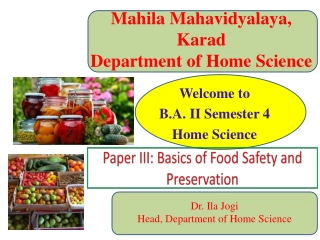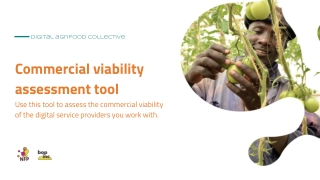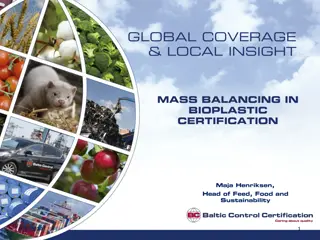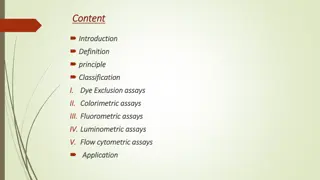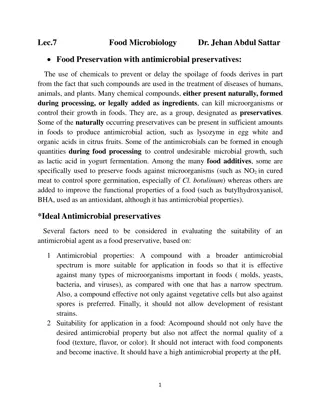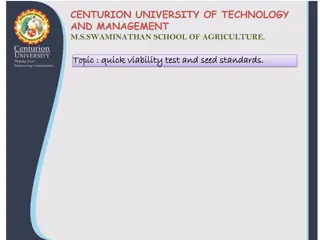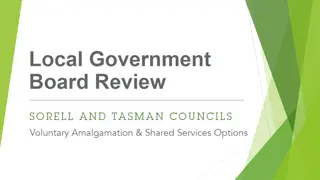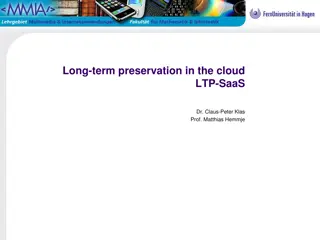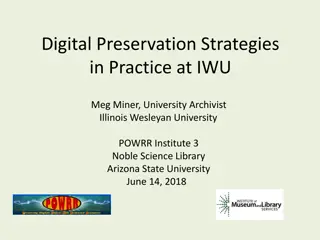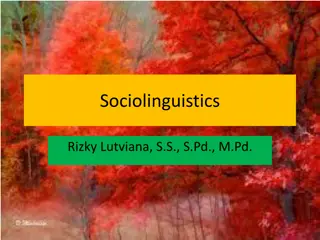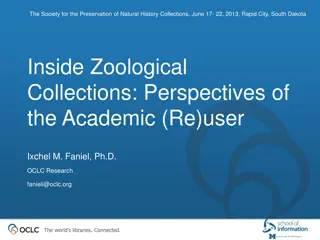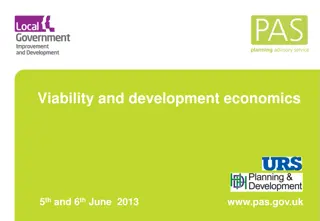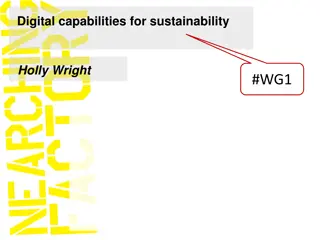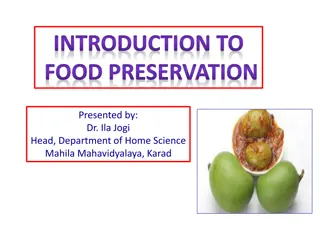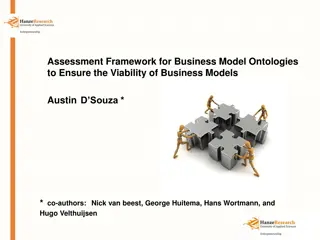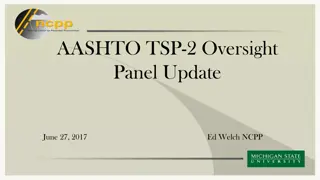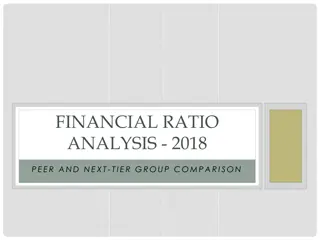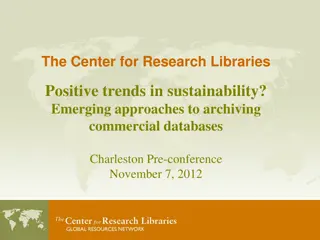Exploring Viability and Sustainability Factors in Language Preservation
The discussion delves into the ultimate criteria for viability, emphasizing survival capabilities beyond logical aspects. It explores sustainability dimensions in minor languages, highlighting the importance of socio-economic factors, communication functionality, and the evolving landscape influenced by technology. The significance of language in identity, written script vitality, and the dominance of international languages in communication are focal points. The narrative touches on challenges faced by minor languages in transitioning to digital mediums and the implications for education and administration.
Download Presentation

Please find below an Image/Link to download the presentation.
The content on the website is provided AS IS for your information and personal use only. It may not be sold, licensed, or shared on other websites without obtaining consent from the author.If you encounter any issues during the download, it is possible that the publisher has removed the file from their server.
You are allowed to download the files provided on this website for personal or commercial use, subject to the condition that they are used lawfully. All files are the property of their respective owners.
The content on the website is provided AS IS for your information and personal use only. It may not be sold, licensed, or shared on other websites without obtaining consent from the author.
E N D
Presentation Transcript
The ultimate criteria of viability must indeed be the capability to survive. This is both a physiological and ecological criterion - and certainly not a logical one. Stafford Beer Many think of sustainability in terms of water, land, fossil fuels. Yet there is a socio-economic dimension which deserves attention too.
EXPLORING THE SUSTAINABILITY EXPLORING THE SUSTAINABILITY OF MINOR LANGUAGES OF MINOR LANGUAGES Dr Leonie Solomons Executive Director, Language Matters, Sri Lanka & Consulting Systems, Australia
Yesterday Regional exclusivity - Hans Losscher Robyn Ashby UK England Sri Lanka Peace Secretariat, Russell Clements let its evolution reveal itself, Geordie accent Prof Peter Allen Models (finding out about the system, )
Language Matters in SL Developed the OCR for Sinhala (4 years - proprietary algorithm, open source with proprietary software to overcome gaps in standardized computing) Introduced Telephone Based Translation Centre for Citizen-Police dialogue Ecopolicy translated into Sinhala and Tamil Evaluation of SL draft constitution (when proposed 2017 + statutes & regulatory instruments) Sustainability of Minor Languages modelling to find out about the system
Relevance of language as part of Relevance of language as part of Identity (groups of people) and what it takes for minor languages, particularly its written script and vocabulary, to be viable. Functionality in terms of communication spoken & written (words, grammar and script) Today with computers becoming the equivalent of pen/pencil, scripts which don't reach computers are taking the path to museums! At times it is facets of their alphabet rather than the whole script, that is being obsoleted by the world of computing
Intuitive Concern - International Languages are dominating communication Medium of instruction for professional education (e.g. Doctors, Engineers, Surveyors, etc. is done in English.) Sending SMS via telephones means youngsters are using the English alphabet to send messages using words in the vernacular. ************************* Longer Term . Bi-lingual or Monolingual Language of Administration (Public Service) Medium of Instruction (Government schools) Handle the language transition with older generation
Modelling Language Sustainability Cybernetic Inference Diagrams (stocks & flows Systems Dynamics) Sensitivity Modelling Bayesian Belief Networks (Probability) VSM
Two-fold objective Boundary Critique Sustainability of Minor Languages Sinhala What is revealed by different modelling techniques
The question is whether the on-going viability of the Sinhala language is sustainable in the longer term, given the emphasis of English as used in ICT and English as the medium of instruction for Professional Qualifications. It is the inroads made by the English alphabetic script (also known as Latin or Roman alphabetic script) as used in its written and read state that is of major concern. What keeps a language in use (as distinct from becoming an ornamental antique) is its ability to deliver functional value in everyday use. This use is primarily for personal conversations, for conducting business transations (products/service), education, deliver public service. This is called the demand for language. The supply side of language thus refers to the number of users of that language, their competence in that language (both written and verbal) and the language keeping abreast of new words as they appear in other languages and thus creating its equivalent in its own language and having it used by is users (both on the demand and supply side) Problem Statement Variable/ Nodes/ Concepts Description of the variable Sinhala Language (alphabetic script -read&write) Sinhala is the official language of administration in the public sector and the medium of instruction in urban and rural schools. Sinhala in formal writing is expressed using refined and sophisticated words and grammar. SLS 1134 (Standards for Sinhala computing) caters for what is known as Level 1 (everyday sinhala), Level 2 (touching and conjuct letters) Level 3 (disused ancient letters). SLS 1134 specifies Level 1 as mandatory. Sinhala is the native language of the Sinhala people who comprise 70% of the Sri Lankan population. About 80% of these Sinhala speaking people are monolingual and literate (read/write). Thus 20% of the Sinhala people are multilingual. Of these 5% are Sinhala-Tamil competent, 94% are Sinhala-English competent and who competent in Sinhala-English-Tamil are 1% . Of the 30% of the non-Sinhala Sri Lankan people, about 10% of them can competently read & write Sinhala. Another 30% of the non-Sinhala people can read and write Sinhala but with poor comprehension and grammar. Thus 18% o f the total population of Sri Lanka cannot read or write Sinhala. Conversational Sinhala for our purposes is categorised into 3 levels - sophiticated, hybrid and colloquial. Conversation in the public service within itself and with citizens uses hybrid Sinhala. colloquial Sinhala Broadcast in Sinhala (TV, Poilitical, trade union and management speeches) use sophisticated Sinhala words and grammar. The medium of instruction in governament schools does likewise. Sinhala people in their day to day communication use a hybrid Sinhala (something between Sophisticated and colloquial) Non-Sinhala people in their day to day communication use Sinhala Language (spoken word - listen & speak) International Finance (imported sense) Sri Lanka, having an open economy has the ability to engage in trade and service activities with other countires. The government foreign policies pave the way for the country to be involved in trade policies, Capital, loans, trade agreements, Exchange rate, Cash flow This sector comprises: phone call centres, Tourism - bulk of staff foreign employment for professionally qualified software in-sourcing, Export (generates income for SL) - service sector Export (generates income for SL) - products Import (generates expenditure for SL) products & services Rural & urban living in Sinhala dominated areas City living in national capital City living in Sinhala dominated provincial capital Garments, Tea, Rubber (Agriculture) Products & software (labeling ingrediants, instruction manuals) Communication is predominately in Sinhala Communication is in English and Sinhala (excluded Tamil language as city living has little relationship to Sinhala language sustainability) Communication is predominately in Sinhala Top Administration in Public Sector use Sinhala-English Career Senior Public servants (e.g those eligible for Car Permits) employed at National, provincial or Local govt use Sinhala astheir prefered mode of communication, althought written English is the preferred choice for professionally qualified public servants - example, judges, lecturers, Secretary, Doctors, Accountants. English, being the link language, is used when Tamil is the other party's language. In the 1950's the language of administration was English. From the 70's, elected politicians increasingly were more competent in Sinhala than in English . Consequently, parliamentary dialogue has become predominately exchanged in Sinhala and this language migration is reflected in the top echelons of the public service too. Public Sector - Administration This catergory includes up to middle management and first line management staff. Sinhala is the medium of communication within these ranks whereas English can be the language when communicating upwards, particularly in Ministries like Foreign Affairs, Finance. English is the primary written language (with Sinhala being the primary spoken language amongst the middle to lower personnel) English-Sinhala Language of all Administration in Private Sector Employment of Professionally qualified Employment of semi-skilled/clerical staff Employment of labouring staff Doctors, Accountants, Engineers, Lawyers, Computer programmers, Surveyors, Marketers, Bankers, Teachers, Chefs, Managers - English language Clerks, Pions, Mechanics, technicians, machinists - Schooled in Sinhala medium with English as second language Sweepers, drivers, farmers, domestics, carpenters, bricklayers, cooks -schooled in Sinhala medium Rural-Urban Sinhala Govt School Education -Sinhala for Sinhala children/parents where Grade 1 - Grade 13 medium of instruction is Sinhala for children with both parents being Sinhala Leading Govt, Semi-Private & International School Education -English where Grade 1 - Grade 13 medium of instruction is English Higher & Professional Education/Qualifications - English Trade Qualifications - Sinhala where university and professional qualifications are taught in English (conversations, group discussions amongst students and lecturerer or amongst students may be spoken in Sinhala Language.) where trades (brick-layer, driver, car mechanic) are taught in vernacular (eg. Sinhala) ICT work Local products & services Sinhala Media, Literature, Arts & Entertainment non-sinhala Media, Literature, Arts & Entertainment Sinhala Culture Religion -Buddhist, Christian (B&C) Religion -non Buddhist, non Christian (non-B&C) Sinhala social identity/status Other Social identity/statis Sinhala-Sinhala race harmony Sinhala-other race harmony Digital Social Media Clubbing ??? Judiciary-citizen Sinhala communication Lower courts-Legal communication in Sinhala Higher courts-Legal communication in English Primary language of President's communication Primary language of parliament's communication Sinhala Notice Boards Computer programme development, Applications and platform, Internet and E- mail (Panel dicussion, local programmers clubs and forum mostly Sinhala driven) Made in SL -food, machinery, repairs, implements (mammooty, brooms) News papers, television, radio, Music, Drama, Dance, Cinema (in sinhala) News papers, television, radio Music, Drama, Dance, Cinema (in English) Sinhala race Traditions, food, rituals, dress Importance given to Sinhala language by Buddhist and Christians Hindu, Islam, etc Social esteem (accorded to knowing Sinhala) within the Sinhala community Social esteem (accorded to knowing Sinhala) outside the Sinhala community relationships within the Sinhala community relationships with non-Sinhala community (eg. Tamils, Muslims) using English alphabetic character set (using English and/or Sinhala words) -Facebook, tweeter, whatsapp, viber, sms English (western, latino, african, bollywood music & dance & dress) clubbing Language of Judiciary-citizen communication is written and spoken in Sinhala (Judiciary -Supreme court, High court, District court, Tribunals) Communication between magistrates (lower courts) and lawyers is in Sinhala Communication between judges (higher courts) and lawyers is in English Sinhala Language as generally used by President (pre-1990,s the President/Governor General communicated in English) Sinhala Language as generally used in parliament (pre-1970's the parliament conducted its discourse in English) Bus destination boards, Direction boards in hospitals, offices, posters (public & Private sector)
Cybernetic Influence Diagram minor language sustainability
Loops Sustainability of Sinhala Language
Sensitivity Modelling Matrix of Criteria Matrix / Influence
VSM System in Focus S1? demand & Supply (per language) (per context) Homeostats (18 by Javier) Demand and supply Environment


